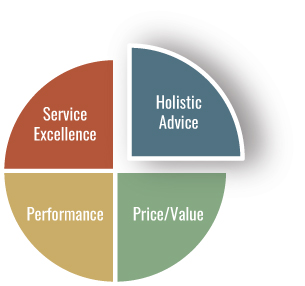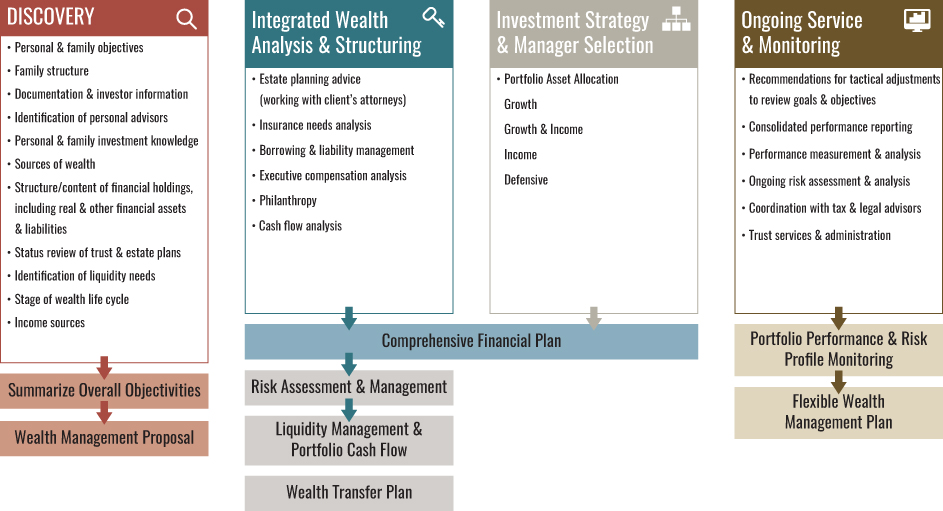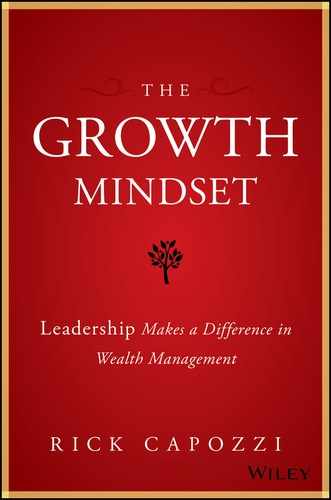Chapter 13
Define Your Business Model
“If you are lucky enough to find a way of life you love, you have to find the courage to live it.”
—John Irving
The term wealth management has become mainstream. It is used everywhere I travel, in leadership meetings of private client firms, in newspaper articles, and by advisors around the world. The term itself can be misleading. With more than 300,000 financial advisors in the United States alone, I have asked many professionals and clients over the past 10 years to describe what wealth management means to them. To no one's surprise, everyone describes it differently, and those descriptions often depend on what training you had, what firm you're with, and the business model you operate under.
There is a very wide spectrum of wealth management services depending on the level of one's wealth. Therefore, it's vital that before you start to think about the different ways to grow your business, you must think about what business model you want to build or expand. Will your firm support this model? For example, if financial planning is one of your core value propositions going forward, it's important to know the firm you're with has an appropriate platform. The $1 million relationships will have different needs and services than the $20 million relationships. As those assets grow, more complexity comes into play and, therefore, a highly competent and skilled team with specialized expertise is necessary. So, where is your sweet spot for your target market? Remember, if you are not the primary advisor on the relationship, you're always vulnerable. If you don't have all of that client's assets, you should use all the tools available to you to understand the goals and purposes of those various assets. You want to be able to see the whole picture, not just a piece of the pie. Based on what clients have told us for decades, they value great service, performance based on achieving their goals, fee transparency and value for what they pay for, and to be treated holistically. Your model must be based on what the client needs.

According to Bain & Company in the report, “Winning in Wealth Management,” global wealth management is a big market in motion. Roughly speaking, investable assets are spread evenly across North America, Europe, and Asia‐Pacific, but the challenges in each region could not be more different. Five nations represent more than half of the $101 trillion total, with the U.S. alone accounting for nearly $30 trillion. But asset growth in these markets remains low, at single‐digit rates. By contrast, the dynamic markets of Asia and Brazil are growing at a rapid pace off a much smaller asset base.
Regardless of your client's level of wealth, you must clearly define how you will help them reach their goals. You should be able to clearly outline those steps and philosophies and create the infrastructure to put them into action. If you truly are delivering real wealth management services, your model should have the following pillars and the right team of experts. It's difficult if not impossible for one person to have all the disciplines. Being holistic and consultative means you start with a life plan. This life plan should include:
- Investment management
- Retirement planning
- Income protection
- Estate planning
- Family healthcare planning
Here is my top‐10 list to help high‐net‐worth clients reach their goals:
- Create a comprehensive life plan. Helping clients determine if they need $5 million for a comfortable retirement is not a plan. The majority of investors don't have an actual life plan. Some firms charge $15,000 for a comprehensive plan while others include it as part of their services. The purpose of this plan is to help your clients define their vision and overall goals and create a strategic and tactical plan that will be executed over time. This plan must be dynamic, just like our lives.
- If the client is still working, encourage him or her to deposit money directly into a retirement account. Taking advantage of corporate retirement plans can be a significant contributor to one's overall assets. However, how many clients keep these assets in fixed income or money market securities is astonishing to me.
- Wealth management is not only about asset growth but also about asset preservation and asset transfer. Work with your clients to create a workable budget, whether they have $2 million or $20 million. I have witnessed people spend $10 million after retiring, and then run out of money because of their poor spending habits. Some people don't have financial discipline, which is why a budget is so critical. Determine what money means to the client; behavior toward money can be a key indicator in determining an appropriate plan.
- It's always better to be debt‐free. Include ways in which the client can reduce her taxes into her comprehensive plan and review them annually.
- Help your clients decide an appropriate plan for their real estate assets. Is having three homes the right long‐term plan? Do they own too much house now? The average home size has increased by more than 1,000 square feet in the past 40 years, from an average size of 1,660 square feet in 1973 to 2,670 in 2013. Ask questions to help the client be realistic about what will suit her needs and budget.
- Be boring (it's not, really) and play the long game. Managing expectations is key. Overall, an equity portfolio can be expected to perform well in the long run. As well, clients want value; therefore the advisor needs to pay attention to fees and help clients achieve the best value for their money.
- Helping clients retire successfully is something that will separate good advisors from the mediocre herd. I'm not talking about just helping them hit a specific dollar number. I mean helping them map out what they will do after retirement. Make contingencies for when plans get derailed by an illness, job loss, or some life‐changing event. Many ease into retirement by transitioning into part‐time work.
- Get the whole family involved. Generally, one person is usually responsible for managing the nest egg. That's a mistake, however, because if or when this person dies, the rest of the family may be in the dark and the learning curve to get up to speed could take years. I have seen this happen repeatedly. Make sure your client's children are a part of the discussions.
- Make sure the client's full team—CPA, attorney, financial planner, and so on—are up to speed and working in concert. You create tangible value when you help simplify the client's life.
- Help your client network with other friends and clients for business opportunities or simply because they share a similar interest.
As you can see, investment management is only part of the model. Think about your model and write down your process, your experiences, and so on. What is your top‐10 list?
Your Vision Should Inspire You to Take Action
Successful advisors know who they are, where they want to go, and how they plan to get there; they know their target market. The key to their success is simple: they do not attempt to be all things to all people; rather, they are all things to some people. They do not attempt to market themselves to a mass audience. We are operating in an overcrowded arena in which everyone becomes your competitor, including robos. Focusing your expertise with laser‐like precision both reduces your competition and helps you to effectively target your defined market. You need to be very clear on how you plan to create a sustainable business model for growth.

Integrated Wealth Management
Know Your Model
The first step in growing your business is to define your business model. Be very clear about your core competencies, investment philosophy, service model, and marketing strategy. Always start by answering the “Why?,” when it comes to the purpose and vision of what you want to achieve. Next, answer the “What?”—the goal or endgame of what you hope to achieve. Once you have a clear process and you've correctly branded the “authentic you,” you'll find yourself in a much better position to know your value, articulate it, and price it accordingly.
Clients tend to ask prospective wealth managers the same key questions. Your response to these questions is what differentiates you from the thousands of other advisors out there. Interested prospects will want to know:
- “What business are you in?”
- “What makes you different?”
- “What processes or strategies would you use with my total financial picture?”
- “How are you going to accomplish my goals?”
And once your business vision is in place, self‐reflection does not end. It's a continual process of evaluation and assessment and reevaluation and reassessment. On a regular basis (e.g., whether yearly or every five years, the time frame is for you to determine) ask yourself:
- What business am I really in? (Do I still enjoy getting up every day?)
- What business would I prefer to be in? (What changes should I make?)
- Have I built the right infrastructure for my practice?
- What's missing from my practice or life that will help me reach greater success?
- What am I creating, promoting, and allowing that's affecting my growth in business or in life?
- Am I reinvesting back into the business to keep up with technology?
The answers to these questions enable you to stay conscious of what's truly important to you, as well as be aware of what you are hoping to accomplish in both your professional and personal life.
The master in the art of living (according to a Zen Buddhist text) makes little distinction between:
- His work and his play
- His labor and his leisure
- His mind and his body
- His education and his recreation
Demonstrate Value
One question I often get in our current environment of fee compression is, “What's one of the best ways that an advisor can demonstrate value?” The short answer is to offer valued holistic advice and an exceptional client experience. Start by doing the unexpected. Do things clients and prospects don't expect, but which give you an opportunity to impress them. Filtering and contextualizing information is paramount. We live in a world of information overload, so the advisor's job is to provide a perspective on all that information.
We live in a world of tangible and intangible value. There are certain things of value that you can actually see, but there are even more that you can't but that you accept are there. What advisors have to remember about intangible value is it requires them to consistently demonstrate, communicate, and quantify that value to each client on a regular basis. And remember, clients and prospects may forget what you said in a meeting or review, but they will always remember how you made them feel. Those soft skills again.
The wealth management industry is large and competitive. But among the highest ranks—as suggested by feedback from more than 400 advisors there is little competition in this well‐differentiated market. As a result, these advisors experience substantial growth year after year.

Important Factors for Selecting an Advisor
The true wealth manager analyzes the client's entire financial picture and focuses on asset accumulation, asset preservation, and asset transfer depending on the specialized needs involved. Therefore, the right wealth management model consists of a team that is competent in all the key areas of financial planning, portfolio management, estate planning, banking, and lending. Although there are many successful sole practitioners, it can be increasingly difficult for one individual to deliver a complete range of wealth management solutions, grow his or her business at double‐digit returns, and still maintain quality of life.
In general, the bank and trust firms have a good process with a dedicated team in contrast to the wirehouse model in which clients may only work with one advisor. However, more and more wirehouses are building teams. Today, the strength, and simultaneously the challenge, of the wirehouse model is the fact that it consists of 56,000 entrepreneurs, each working independently. Therefore, they have individuals with a wide range of experiences, processes, team structures, and so forth. The wirehouse model needs to evolve faster to catch up with where the industry is headed. With improved technology, greater empowerment given to the local manager and advisor will better serve the client. The independent and RIA channels are the fastest growing and will continue to take market share because these advisors have more control over the way they run their business and have the opportunity to build their own brand, not to mention building equity.
Whatever business model you choose, it's important to focus on your value proposition and follow a systematic approach to meeting your goals. Cary Greenspan of PNC was kind enough to talk with me about his experiences and what he sees for the future of the industry.
Rick: Please tell me a little about yourself and your role at PNC.
Cary: I will very soon be entering my 35th year of continuous investment and portfolio management experience. After graduating with an MBA, I followed a slightly unconventional MBA path, becoming a stockbroker with Kidder, Peabody and Company in Washington, D.C. I also started an RIA and had various positions over the years. Today I serve on many executive committees for the PNC Asset Management Group. To name a few, I am a member of the Investment Policy Committee, the Investment Advisor Research Committee, and the Derivatives Policy Committee. My primary responsibilities include but are not limited to contributing to the overall investment thought leadership within PNC. This would include contributions and thoughts related to overall economic and financial conditions, how asset classes may be likely to perform, and how investment solutions are likely to provide a benefit or a detriment to client portfolios. I am also ultimately responsible for the fiduciary manner in which investment officers manage their portfolios.
Rick: You have been working with high‐net‐worth individuals for a long time. How do you see the business evolving going forward?
Cary: As in many industries, technology and access to information has become extraordinarily friendly to the entire investment client base. Lower costs, access to information, and the relative ease by which an investor can discover investment solutions or assistance to investment questions has made fee compression a challenge across all facets of the industry. In general, I see this trend continuing. The continual evolution of better products, easier access, and general solutions that will suit most investors' objectives will keep prices low. Even high‐net‐worth investors have significantly more options available to them now than ever before. Firms that make a concerted effort to fully understand the client's personal need and not their superficial and obvious financial need will be able to not only retain current clients but obtain significantly more clients who are otherwise somewhat indifferent to providers. Firms that offer no compelling personal or professional difference will force themselves into price reductions as they will offer no distinguishable advantages. Companies that suggest that client service is the primary focus often do not understand what they are measuring or how to deliver service to a client so that the client feels the value delivered. Investors who truly can feel different about their relationship with a provider will be completely engaged and truly dedicated to that firm and to those specific officers who provide that personal and professional assistance.
Rick: When it comes to core competencies, what do you think are the essential skills for an advisor in the future to be successful?
Cary: In part of a training program I both participated in and eventually taught, two questions would be asked at the outset to all participants. The first question was, “What was your major in college?” The second question was, “Knowing what you now know about this business, what major would you have wanted to study in college that would help you most now?” Typically 60 to 70 percent of the respondents to the first question had a technical major: business, finance, accounting, economics, pre‐law, math, and so on. The answer for the second question (in the same percentages to the first question) was psychology, sociology, psychotherapy, and so on. I provide the anecdote to once again distinguish technical skill sets from interpersonal and personal skill sets. A person employed in wealth management or asset management must possess the technical knowledge base required to make sound judgments and offer practical advice. This is an absolute. Our business has thousands of incredibly intelligent JDs, CFAs, CPAs, CFPs, and other equally impressive credentialed professionals who provide remarkably similar and remarkably good counsel. But that does not always make the client feel that value has been achieved. Every client expects that he or she will be provided cogent and sound advice. And rightly so. But clients might receive the same advice and service next door for a lower fee. At what point do we assist the client with developing his or her sense of value and the personal dedication that we have as a company and as a person? The future skill set that is required is one of interpersonal skills and relationship development. Companies and individuals that invest in developing these skills will be far ahead of other competitors.
Rick: From the client's perspective in creating a positive client experience, what does that look like?
Cary: As I said earlier, clients rarely distinguish one provider from another until a relationship has developed. For the moment, if you remove the client aspect and only consider your own personal relationships, do you automatically trust someone you have just met, much less trust him or her completely? Don't you need some time to develop a trust between you and someone else? Granted this is a different circumstance. But the point to consider is that a client experience must go through stages like any relationship would. A client, however, has some formality associated with our actions. This is about setting expectations and meeting expectations. How often have we mishandled a new relationship and felt the sting of that for an extended period of time? Formal relationships require extraordinary communication and dedicated care. This cannot be left to chance. Clients know they have choices and new clients are now more vulnerable than ever before. Creating not only a positive client experience but a distinguishable, even remarkable client experience is how you add value. This is how a client will remember you. This is how a client will want to stay with you. And it is how you will obtain new clients. Your clients will be thrilled with their experience because it is not a common occurrence. Appropriate and adequate advice, adequate communication, and adequate performance is a general client expectation. Being able to excel in one of these three areas will foster a tremendous relationship. Executing on all three will create a multigenerational client with hundreds of friends and colleagues to follow.
